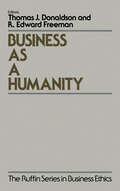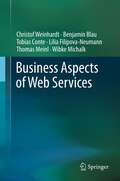- Table View
- List View
Business and the Sustainable Development Goals: Measuring and Managing Corporate Impacts
by Norma Schönherr André MartinuzziThis innovative and engaging book discusses the contribution of business to the Sustainable Development Goals (SDGs) adopted by the United Nations in 2015. It critically analyses selected impact measurement and management tools to highlight their respective benefits and limitations, and also provides guidance on critical management decisions to support high-quality impact measurement and management. The analyses underlying this book are the result of a three year research project conducted by an international consortium in the EU-funded research project GLOBAL VALUE – Managing Business Impact on Development. The research is complemented by examples from corporate practice and expert interviews to demonstrate and measure the contribution of business to sustainable development in the context of the SDGs.
Business Angel Hansi Hansmann: Das Erfolgsgeheimnis hinter runtastic, shpock, mySugr und vielen anderen Start-ups
by Lisa Ittner Florian NovakWenn ein Business Angel in ein Start-up involviert ist, steigt die Erfolgswahrscheinlichkeit. Der erfolgreiche Österreicher Hansi Hansmann gilt als empathischer Zahlenmensch, der gerne gewinnt und nur mit Menschen arbeitet, die er auch mag. Dieses Buch gewährt Einblicke in sein Wesen und Denken, seine Auswahlkriterien, seine Rolle als Berater und Förderer. Er selbst kommt ebenso im Interview zu Wort wie seine Gründerfreunde. Der Leser erfährt im Klartext, worauf es ihm und den Gründern wirklich ankommt – um die Prinzipien und Einsichten für sich selbst zu adaptieren. Eine frische, inspirierende und gewinnbringende Lektüre für Investoren, Gründer und alle, die mehr über Hansmanns Erfolgsgeheimnis wissen wollen: Mensch bleiben und nachhaltig erfolgreich sein ist kein Widerspruch, sondern der entscheidende Schlüssel.
Business Angels: Der informelle Beteiligungskapitalmarkt in Deutschland
by Malte Brettel Cyril Jaugey Cornelius RostBusiness Angels überbrücken, so jedenfalls die Studien in den USA und dem europäischen Ausland, eine entscheidende Finanzierungsphase für junge Unternehmen. Dieses Buch setzt sich intensiv mit dem Beteiligungsverhalten von Business Angels in Deutschland auseinander. Gründer auf der Suche nach Kapital, Risikokapitalgeber, die etwas über alternative Finanzierungen erfahren wollen, und an Finanzierungsfragen wissenschaftlich Interessierte finden hier wertvolle Informationen.
Business Architecture: A Practical Guide
by Jonathan Whelan Graham MeadenOrganizations today exist in an environment of unprecedented change. They do so against a backdrop of a global, competitive marketplace, the fast-paced enablement of technology, amplified regulation and accelerating organizational complexity. Many organizations are addressing change in a sub-optimal way and they are operating without a clear view of where their operational risks lie. It is these dynamics that are leading organizations to recognise and embrace Business Architecture. Despite this environment, Business Architecture can be a difficult ’sell’ - it is often perceived to be abstract and lacking in tangible delivery. To succeed, Business Architecture must be pragmatic and, to be sustainable, it must focus on achieving long-term value and, at the same time, recognise the shorter-term tactical needs of the organisation. With these challenges in mind, this book provides a practical guide on how to employ Business Architecture and how to build a balanced proposition that delivers value to a broad range of stakeholders. As the book states, Business Architecture should not be practised in isolation, nor should it be thought of as a one-off process; it needs to be woven into the fabric of the organization. And so the authors illustrate the opportunities for weaving the Business Architecture Practice into this fabric through the various stakeholders and life cycles that exist, both formally and informally, within an organization. Whilst recognizing best practice, this book explores a new, inspirational level of Business Architecture whilst acknowledging that the best way to realize the vision is one step at a time.
Business Architecture: A Practical Guide
by Jonathan Whelan Graham MeadenOrganizations today exist in an environment of unprecedented change. They do so against a backdrop of a global, competitive marketplace, the fast-paced enablement of technology, amplified regulation and accelerating organizational complexity. Many organizations are addressing change in a sub-optimal way and they are operating without a clear view of where their operational risks lie. It is these dynamics that are leading organizations to recognise and embrace Business Architecture. Despite this environment, Business Architecture can be a difficult ’sell’ - it is often perceived to be abstract and lacking in tangible delivery. To succeed, Business Architecture must be pragmatic and, to be sustainable, it must focus on achieving long-term value and, at the same time, recognise the shorter-term tactical needs of the organisation. With these challenges in mind, this book provides a practical guide on how to employ Business Architecture and how to build a balanced proposition that delivers value to a broad range of stakeholders. As the book states, Business Architecture should not be practised in isolation, nor should it be thought of as a one-off process; it needs to be woven into the fabric of the organization. And so the authors illustrate the opportunities for weaving the Business Architecture Practice into this fabric through the various stakeholders and life cycles that exist, both formally and informally, within an organization. Whilst recognizing best practice, this book explores a new, inspirational level of Business Architecture whilst acknowledging that the best way to realize the vision is one step at a time.
Business Architecture Management: Architecting the Business for Consistency and Alignment (Management for Professionals)
by Daniel Simon Christian SchmidtThis book presents a comprehensive overview of enterprise architecture management with a specific focus on the business aspects. While recent approaches to enterprise architecture management have dealt mainly with aspects of information technology, this book covers all areas of business architecture from business motivation and models to business execution. The book provides examples of how architectural thinking can be applied in these areas, thus combining different perspectives into a consistent whole. In-depth experiences from end-user organizations help readers to understand the abstract concepts of business architecture management and to form blueprints for their own professional approach. Business architecture professionals, researchers, and others working in the field of strategic business management will benefit from this comprehensive volume and its hands-on examples of successful business architecture management practices.
Business Architecture Strategy and Platform-Based Ecosystems
by Young Won ParkThis book provides a framework and real case analyses concerning business architecture strategy and platform-based ecosystems. Firstly, the book introduces a framework of business architecture strategy and suggests an engineering process that employs a business architecture analysis system in which the various business best-practices information technology (IT) tools are integrated into an interface. More specifically, this architecture analysis provides the means to realize two essential features: a strategy that allows global firms to sense changing market needs, and a tool that combines mechanical engineering with electronics and software IT tools.Secondly, the book discusses platform-based ecosystems. Crucial issues for today’s firms are associated with value creation through their platform and ecosystem framework. With a major emphasis on modular product architecture, US firms have focused heavily on platform development in modular industries. Their base is operation system (OS) software, so that IT firms in general focus on software capabilities—and digital control in particular. In contrast, the advantage for Japanese firms is not digital but analog control. Without any drastic changes in their industry practices, Japanese firms are likely to sustain their analog platform advantage. The book subsequently puts forward a holistic view through the connection of business architecture strategy and platform-based ecosystems. The theoretical framework and case illustrations are especially useful to firms involved in a variety of industries that must respond to the turbulent environmental changes of the digital era. Most of the cases target not only Japanese firms but also many other global firms. Readers are systematically shown how to balance technological competence and customer competence by using the framework of business architecture strategy and platform-based ecosystems.
Business As a Humanity (The Ruffin Series in Business Ethics)
by Thomas Donaldson R. Edward FreemanThis latest volume in the acclaimed Ruffin Series in Business Ethics brings together the contributions to the annual Ruffin Lecture series, in which some of the leading scholars in business ethics addressed the question: Can business, and business education, be considered one of the humanities, or is it in a class by itself? At a time when business is coming under attack for its apparent transgressions, this book illuminates the special values that inhere in the business world. Arguing all sides of the issue, the distinguished contributors include Richard DeGeorge, Ronald Green, Thomas Dunfee, Robert Solomon, Edwin Hartman, Peter French, Patricia Werhane, Clarence Walton, W. Michael Hoffman, David Fedo, Kenneth Andrews, Joanne Ciulla, Manuel Velasquez, and George Brenkert. The editors contribute an informative Introduction and an Epilogue to set the debate in its proper context.
Business as a System of Power
by Robert BradyBusiness as a System of Power was the direct product of extensive and continuing study of the rise of bureaucratic centralism. The project was begun in 1934, and resulted a decade later in this volume, arguably the most important work in comparative and historical economics to emerge in the World War Two period. Indeed, Brady's theorems such as the bureaucratic authoritarian model of development, became a touchstone for the study of Third World economies.Brady saw the direction of business moving in a variety of directions: from the totalitarian model set by fascism with its highly centralized approach to special interests, profit making and policy made in the interests of those who rule; and the alternative democratic model set by the democracies of the West, which expound the latitude of direct public participation in decision-making and social organization of the economy as a whole. Brady does not indulge in cheap conspiracy theory. Rather he sees the business classes worldwide as possessing a collective mind, but not a collective will. In this setting the business civilization itself is at stake.The volume offers a fascinating study of German Nazism, Italian fascism and Japanese militarism as a series of policies rather than historical inevitabilities. But the work is also a foreboding and a warning to democratic varieties of capitalism. As business becomes increasingly global in character, unbound by national interests or democratic aims, it also becomes more rational in its own terms. Its drive for maximizing profits with scant regard to what may be less cost effective, but more open to popular control or participation, becomes transparent. Brady provides a remarkably prescient, albeit controversial, study of trends in Western democracy and big business. Robert S. Lynd, in his Preface, writes, "Brady cuts through to the central problem disrupting our worldàa world-wide counter-revolution against democracy." More than a half century later, in his outstanding review of the life and career of Robert Brady, Douglas Dowd points to the same lessons: economic inequities, economic globalization and political concentration of power. "In such a world, the counsel of a Brady never loses its vitality."Robert A. Brady was professor of economics at Columbia University, and author of The Rationalization Movement in German Industry; The Spirit and Structure of German Fascism; and The Scientific Revolution in Industry. Douglas F. Dowd was professor of economics at Johns Hopkins University and author of a number of important books on economics, including Modern Economic Problems in Historic Perspective.
Business as a System of Power
by Robert BradyBusiness as a System of Power was the direct product of extensive and continuing study of the rise of bureaucratic centralism. The project was begun in 1934, and resulted a decade later in this volume, arguably the most important work in comparative and historical economics to emerge in the World War Two period. Indeed, Brady's theorems such as the bureaucratic authoritarian model of development, became a touchstone for the study of Third World economies.Brady saw the direction of business moving in a variety of directions: from the totalitarian model set by fascism with its highly centralized approach to special interests, profit making and policy made in the interests of those who rule; and the alternative democratic model set by the democracies of the West, which expound the latitude of direct public participation in decision-making and social organization of the economy as a whole. Brady does not indulge in cheap conspiracy theory. Rather he sees the business classes worldwide as possessing a collective mind, but not a collective will. In this setting the business civilization itself is at stake.The volume offers a fascinating study of German Nazism, Italian fascism and Japanese militarism as a series of policies rather than historical inevitabilities. But the work is also a foreboding and a warning to democratic varieties of capitalism. As business becomes increasingly global in character, unbound by national interests or democratic aims, it also becomes more rational in its own terms. Its drive for maximizing profits with scant regard to what may be less cost effective, but more open to popular control or participation, becomes transparent. Brady provides a remarkably prescient, albeit controversial, study of trends in Western democracy and big business. Robert S. Lynd, in his Preface, writes, "Brady cuts through to the central problem disrupting our worldàa world-wide counter-revolution against democracy." More than a half century later, in his outstanding review of the life and career of Robert Brady, Douglas Dowd points to the same lessons: economic inequities, economic globalization and political concentration of power. "In such a world, the counsel of a Brady never loses its vitality."Robert A. Brady was professor of economics at Columbia University, and author of The Rationalization Movement in German Industry; The Spirit and Structure of German Fascism; and The Scientific Revolution in Industry. Douglas F. Dowd was professor of economics at Johns Hopkins University and author of a number of important books on economics, including Modern Economic Problems in Historic Perspective.
Business as an Instrument for Societal Change: In Conversation with the Dalai Lama
by Sander TidemanBusiness as an Instrument for Societal Change: In Conversation with the Dalai Lama is the result of two decades of research and dialogue with His Holiness the Dalai Lama and other leaders in business, government, science and education. Author Sander Tideman, a lawyer and banker who has maintained a friendship with the Dalai Lama over all these years, presents a practical framework and methodology to develop a new kind of leadership - one fit to repurpose the business world and tackle escalating social, economic and environmental needs. The Dalai Lama rarely speaks directly on the topics of business, leadership and economics. Yet in the dialogues recounted here, his wisdom - combined with key insights from business and public leaders -creates a unified shift towards a consciousness of interconnectedness, offering profound insights for practitioners and general readers alike. Tideman unites the scientific worldviews of physics, neuroscience and economics with the positive psychology of human relationships, and ancient spiritual wisdom, to formulate practical business leadership solutions. While recognizing the need for change in external structures and governance, Tideman highlights the importance of opening our minds, and connecting inner and outer spirituality. At the same time, he focuses on concrete practices for winning the hearts and minds of employees, customers, communities, and society at large, while addressing deep-rooted problems such as extreme social inequality and continued financial collapses. At the heart of this book lies the journey to discover our shared purpose. This ignites new sources of value creation for the organisation, customers and society, which Tideman terms 'triple value'. We can achieve triple value by aligning societal and business needs, based on the fundamental reality of interconnection. Business as an Instrument for Societal Change: In Conversation with the Dalai Lama is a readable and intelligent exploration of how leaders can actually help to shape a sustainable global economy by embracing innate human and humane behaviour. It is also Tideman's fascinating personal journey, which brought him to question the underlying motivations and goals of business leadership and to seek a new paradigm for a more sustainable approach. Reflecting Tideman's sharp perceptions and infused with the Dalai Lama's unmistakable joy, this book has the power to change your way of thinking.
Business as an Instrument for Societal Change: In Conversation with the Dalai Lama
by Sander TidemanBusiness as an Instrument for Societal Change: In Conversation with the Dalai Lama is the result of two decades of research and dialogue with His Holiness the Dalai Lama and other leaders in business, government, science and education. Author Sander Tideman, a lawyer and banker who has maintained a friendship with the Dalai Lama over all these years, presents a practical framework and methodology to develop a new kind of leadership - one fit to repurpose the business world and tackle escalating social, economic and environmental needs. The Dalai Lama rarely speaks directly on the topics of business, leadership and economics. Yet in the dialogues recounted here, his wisdom - combined with key insights from business and public leaders -creates a unified shift towards a consciousness of interconnectedness, offering profound insights for practitioners and general readers alike. Tideman unites the scientific worldviews of physics, neuroscience and economics with the positive psychology of human relationships, and ancient spiritual wisdom, to formulate practical business leadership solutions. While recognizing the need for change in external structures and governance, Tideman highlights the importance of opening our minds, and connecting inner and outer spirituality. At the same time, he focuses on concrete practices for winning the hearts and minds of employees, customers, communities, and society at large, while addressing deep-rooted problems such as extreme social inequality and continued financial collapses. At the heart of this book lies the journey to discover our shared purpose. This ignites new sources of value creation for the organisation, customers and society, which Tideman terms 'triple value'. We can achieve triple value by aligning societal and business needs, based on the fundamental reality of interconnection. Business as an Instrument for Societal Change: In Conversation with the Dalai Lama is a readable and intelligent exploration of how leaders can actually help to shape a sustainable global economy by embracing innate human and humane behaviour. It is also Tideman's fascinating personal journey, which brought him to question the underlying motivations and goals of business leadership and to seek a new paradigm for a more sustainable approach. Reflecting Tideman's sharp perceptions and infused with the Dalai Lama's unmistakable joy, this book has the power to change your way of thinking.
Business Aspects of Web Services
by Christof Weinhardt Benjamin Blau Tobias Conte Lilia Filipova-Neumann Thomas Meinl Wibke MichalkDriven by maturing Web service technologies and the wide acceptance of the service-oriented architecture paradigm, the software industry’s traditional business models and strategies have begun to change: software vendors are turning into service providers. In addition, in the Web service market, a multitude of small and highly specialized providers offer modular services of almost any kind and economic value is created through the interplay of various distributed service providers that jointly contribute to form individualized and integrated solutions. This trend can be optimally catalyzed by universally accessible service orchestration platforms – service value networks (SVNs) – which are the underlying organizational form of the coordination mechanisms presented in this book.Here, the authors focus on providing comprehensive business-oriented insights into today’s trends and challenges that stem from the transition to a service-led economy. They investigate current and future Web service business models and provide a framework for Web service value networks. Pricing mechanism basics are introduced and applied to the specific area of SVNs. Strategies for platform providers are analyzed from the viewpoint of a single provider, and so are pricing mechanisms in service value networks which are optimal from a network perspective. The extended concept of pricing Web service derivatives is also illustrated. The presentation concludes with a vision of how Web service markets in the future could be structured and what further developments can be expected to happen.This book will be of interest to researchers in business development and practitioners such as managers of SMEs in the service sector, as well as computer scientists familiar with Web technologies. The book’s comprehensive content provides readers with a thorough understanding of the organizational, economic and technical implications of dealing with Web services as the nucleus of modern business models, which can be applied to Web services in general and Web service value networks specifically..
Business Associations and the Financing of Political Parties: A Comparative Study of the Evolution of Practices in Germany, Norway and Japan
by Arnold J. Heidenheimer Frank C. LangdonStudents of government and social power recognize that wherever governmental systems embrace popular elections, the functions and mechanisms of political finance constitute inevitable links of influence between economic structures and political processes. The transmu tation of economic power into political power has been of historic concern from ancient philosophers to modern political scientists. Efforts to discern and interpret the political roles of those engaged in funding candidates and political parties have intensified in recent years. Attention given the subject has deepened substantially in the United States since World War II and, while there have been differ ences in range and quality, serious analytical interests have also developed in numerous other nations around the world. These trends have been accompanied by increasingly more energetic and sophisti cated attempts at comparative analysis. Problems in transnational studies of political processes have always been formidable. The comparative study of political finance has been retarded by difficulties in defining units of analysis that make it possible to identify in some measurable way the effects of political fmance in precise phases of the governing process, e. g. , in the per suasion of voters, in party nominating processes, in executive decision making. Cash transactions, even when known with confidence, consti tute only a partial aspect of political finance. Other shades of economic power may be equally relevant, involving services or goods directly provided, credits and other economic benefits extended or withheld, and the exercise of less tangible but equally potent influence.
Business at a Crossroads: The Crisis of Corporate Leadership
by Tom LloydRecent events suggest liberal capitalism harbours two dangerous seeds of self-destruction; growing inequality and a tendency for markets to spiral out of control. This book advocates the restoration to an earlier state of another sub-system of liberal capitalism, some of the features of which lie at the heart of liberal capitalism's malaise.
Business at the Speed of Now: Fire Up Your People, Thrill Your Customers, and Crush Your Competitors
by John M. BernardA technology-enabled management philosophy to accelerate your organization Business at the Speed of Now delivers a new real-time management philosophy and system to leaders looking for better results in today's constantly changing market. Companies that inspire and equip employees and expect them to seize opportunities and solve problems in the now will enjoy a distinct competitive advantage in a world where speed matters most. Get systematic advice on how to build an integrated and transparent management system, enabled by cloud computing and internal social networks. Use this comprehensive guide to create a NOW organization where everyone boldly pursues every opportunity every time. The vast majority of businesses cling to a THEN management model and philosophy designed to prevent immediate action. In this practical handbook, you'll learn how to apply technology to the three essential types of work: Fundamentals (routine work that consumes 95 percent of all resources), Breakthroughs (initiatives that can change the game), and Problems (daily challenges and crises that occur in all organizations). Provides a wealth of real-world examples, assessments, tools, guidelines, and checklists that enable readers to apply the concepts immediately Offers practical tools for building accountability and transparency into every position, thereby eliminating the loose ends that so often cause business execution to stumble Presents the groundbreaking insights of John Bernard, an expert on management theory and practice, the use of social media inside the organization, and the modern workforce, whose company, Mass Ingenuity, consults around the world and develops Web-based tools to support real-time management Set your organization free from the old THEN management ways that no longer get the results you need. Adopt the new NOW management thinking and the state-of-the-art tools that will get your organization doing business at the speed of now.
Business at the Speed of Now: Fire Up Your People, Thrill Your Customers, and Crush Your Competitors
by John M. BernardA technology-enabled management philosophy to accelerate your organization Business at the Speed of Now delivers a new real-time management philosophy and system to leaders looking for better results in today's constantly changing market. Companies that inspire and equip employees and expect them to seize opportunities and solve problems in the now will enjoy a distinct competitive advantage in a world where speed matters most. Get systematic advice on how to build an integrated and transparent management system, enabled by cloud computing and internal social networks. Use this comprehensive guide to create a NOW organization where everyone boldly pursues every opportunity every time. The vast majority of businesses cling to a THEN management model and philosophy designed to prevent immediate action. In this practical handbook, you'll learn how to apply technology to the three essential types of work: Fundamentals (routine work that consumes 95 percent of all resources), Breakthroughs (initiatives that can change the game), and Problems (daily challenges and crises that occur in all organizations). Provides a wealth of real-world examples, assessments, tools, guidelines, and checklists that enable readers to apply the concepts immediately Offers practical tools for building accountability and transparency into every position, thereby eliminating the loose ends that so often cause business execution to stumble Presents the groundbreaking insights of John Bernard, an expert on management theory and practice, the use of social media inside the organization, and the modern workforce, whose company, Mass Ingenuity, consults around the world and develops Web-based tools to support real-time management Set your organization free from the old THEN management ways that no longer get the results you need. Adopt the new NOW management thinking and the state-of-the-art tools that will get your organization doing business at the speed of now.
Business at the Speed of Thought: Succeeding in the Digital Economy (Penguin Readers #Bk. 6)
by Bill Gates Collins HemingwayMost companies have a sizeable investment in technology but are realising only 20% of its potential benefit. BUSINESS @ THE SPEED OF THOUGHT introduces the concept of the digital nervous system which unites all systems and processes under one common infrastructure, allowing companies to make quantum leaps in efficiency, growth and profit. Using detailed tours of Microsoft and other major corporations, Gates demonstrates how integrated technology can transform any business by energizing its three major elements: customer/partner relationships, employees and process, and offers practical suggestions on how this can be achieved.
Business Automation and Its Effect on the Labor Force: A Practical Guide for Preparing Organizations for the Fourth Industrial Revolution
by Edward UechiBusiness Automation and Its Effect on the Labor Force informs business managers on new technologies that can make their industries more efficient. This book provides a primer on quantum computing, artificial intelligence, robotics, and sensors. As a business management book, managers can start planning for the future. The author predicts when the advanced systems would be ready to use. Getting a clearer picture of what is on the horizon, business managers can determine how many workers and machines will be needed. Managers will learn how to calculate the optimal mix of workers and machines. Key Book Highlights Covering labor and technology in agriculture, manufacturing, construction, transportation, hospitality, health care, office administration, and education. A review of the evolution of systems, machines, and devices from the past to the present, and where the latest advancement is headed. A visual timeline showing when new systems and machines would be available for eight industries in the next 25 years. Succinct descriptions of eliminated jobs, retained jobs, and new roles for workers. A simplified method to calculate the costs of operations, allowing business managers to compare human productivity against machine productivity. Labor market information in context of technological innovation for state workforce agencies and local workforce development boards. Lists of occupations with Standard Occupational Classification (SOC) codes for labor economists, workforce development specialists, and job seekers.
Business Automation and Its Effect on the Labor Force: A Practical Guide for Preparing Organizations for the Fourth Industrial Revolution
by Edward UechiBusiness Automation and Its Effect on the Labor Force informs business managers on new technologies that can make their industries more efficient. This book provides a primer on quantum computing, artificial intelligence, robotics, and sensors. As a business management book, managers can start planning for the future. The author predicts when the advanced systems would be ready to use. Getting a clearer picture of what is on the horizon, business managers can determine how many workers and machines will be needed. Managers will learn how to calculate the optimal mix of workers and machines. Key Book Highlights Covering labor and technology in agriculture, manufacturing, construction, transportation, hospitality, health care, office administration, and education. A review of the evolution of systems, machines, and devices from the past to the present, and where the latest advancement is headed. A visual timeline showing when new systems and machines would be available for eight industries in the next 25 years. Succinct descriptions of eliminated jobs, retained jobs, and new roles for workers. A simplified method to calculate the costs of operations, allowing business managers to compare human productivity against machine productivity. Labor market information in context of technological innovation for state workforce agencies and local workforce development boards. Lists of occupations with Standard Occupational Classification (SOC) codes for labor economists, workforce development specialists, and job seekers.
Business Basics for Dentists
by James L. Harrison David O. Willis Charles K. ThiemanBusiness Basics for Dentists Concise yet comprehensive overview of business management principles tailored for dental practices, with strategies to apply the core concepts to achieve success Rather than presenting a rote checklist of steps for success, Business Basics for Dentists, Second Edition describes business, economic, marketing, and management principles and explains how to apply them to dental practice. Now fully updated throughout, this book provides the essential elements of a business course—management principles, economics, business finance, and financial analysis—without getting bogged down in too much detail. Dental students and new practitioners will learn how to use the core strategic and operational business philosophies to develop an effective dental practice. The business management principles are related to various aspects of running and managing a dental practice, including office communications, billing, inventory, and marketing. All aspects of practice transition are approached, including career opportunities, buying a practice, starting a new practice, multi-practitioner arrangements, practice valuation, and planning and developing a practice. The book also covers personal financial planning to ensure that the dentist is also planning for their finances and retirement beyond the bounds of the practice. Business Basics for Dentists, Second Edition covers: Personal money management and insurance needs, reducing the personal tax burden, estate planning, and securing financing Business entities, basic economics, the legal environment of the dental practice, financial statements, and business taxes and tax planning Management principles, planning the dental practice, financial analysis, and control in the dental office, maintaining production and collections, and gaining case acceptance Generating patients for the practice, controlling costs, promoting staff effectiveness, and maintaining daily operations Focusing on the transition period from a dental student, through corporate employee, to ownership, Business Basics for Dentists is a valuable tool for dental students and professionals seeking to further their career path through actionable advice from experts in the field.
Business Basics for Dentists
by James L. Harrison David O. Willis Charles K. ThiemanBusiness Basics for Dentists Concise yet comprehensive overview of business management principles tailored for dental practices, with strategies to apply the core concepts to achieve success Rather than presenting a rote checklist of steps for success, Business Basics for Dentists, Second Edition describes business, economic, marketing, and management principles and explains how to apply them to dental practice. Now fully updated throughout, this book provides the essential elements of a business course—management principles, economics, business finance, and financial analysis—without getting bogged down in too much detail. Dental students and new practitioners will learn how to use the core strategic and operational business philosophies to develop an effective dental practice. The business management principles are related to various aspects of running and managing a dental practice, including office communications, billing, inventory, and marketing. All aspects of practice transition are approached, including career opportunities, buying a practice, starting a new practice, multi-practitioner arrangements, practice valuation, and planning and developing a practice. The book also covers personal financial planning to ensure that the dentist is also planning for their finances and retirement beyond the bounds of the practice. Business Basics for Dentists, Second Edition covers: Personal money management and insurance needs, reducing the personal tax burden, estate planning, and securing financing Business entities, basic economics, the legal environment of the dental practice, financial statements, and business taxes and tax planning Management principles, planning the dental practice, financial analysis, and control in the dental office, maintaining production and collections, and gaining case acceptance Generating patients for the practice, controlling costs, promoting staff effectiveness, and maintaining daily operations Focusing on the transition period from a dental student, through corporate employee, to ownership, Business Basics for Dentists is a valuable tool for dental students and professionals seeking to further their career path through actionable advice from experts in the field.
Business Basics for Private Practice: A Guide for Mental Health Professionals
by Anne D. BartolucciBusiness Basics for Private Practice is a step-by-step guide to developing a successful practice from initial conceptualization and business plan to future growth for the true entrepreneur. Dr. Bartolucci draws from interviews with fellow mental health practitioners and experts in business-related fields to make even the most intimidating parts of practice easy to understand. Business Basics is written to give the feel of mentorship, and the author talks about lessons learned the hard way. She’s also included checklists and worksheets to help you stay organized and ready to meet the challenges of opening a private practice.
Business Basics for Private Practice: A Guide for Mental Health Professionals
by Anne D. BartolucciBusiness Basics for Private Practice is a step-by-step guide to developing a successful practice from initial conceptualization and business plan to future growth for the true entrepreneur. Dr. Bartolucci draws from interviews with fellow mental health practitioners and experts in business-related fields to make even the most intimidating parts of practice easy to understand. Business Basics is written to give the feel of mentorship, and the author talks about lessons learned the hard way. She’s also included checklists and worksheets to help you stay organized and ready to meet the challenges of opening a private practice.

















